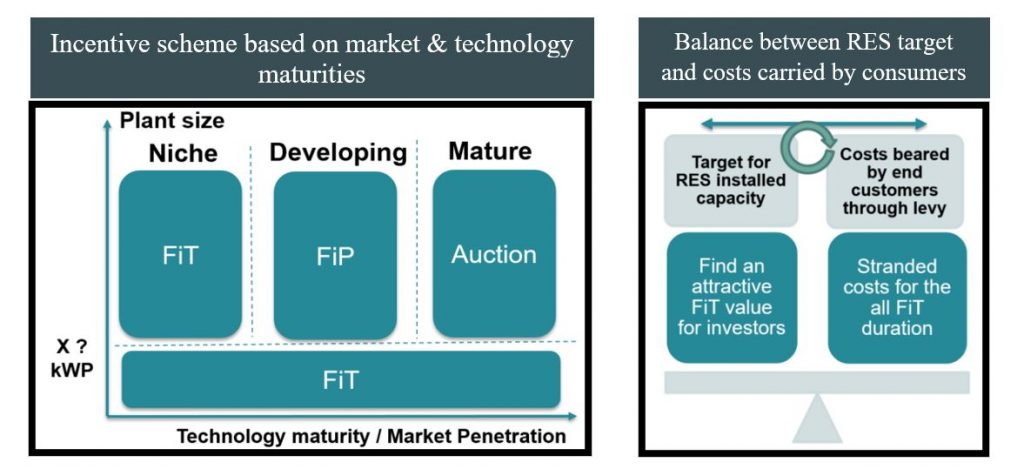Time to set lessons learned on incentive schemes for RES
Climate action is gaining traction as new roadmaps are announced to meet the Paris Agreement’s CO2 mitigation goals. Since the implementation of renewable energy sources (RES) is critical to meet these goals, now is a good time to review what has been accomplished in terms of RES policies in pioneer countries. The aim should be to understand and adapt past lessons to allow a cost-effective global scaling of RES installed capacity.
What is a Feed-in-Tariff (FiT)?
FiT is a fixed electricity price that is paid to RES producers for each unit of energy produced and injected into the grid. The payment of the FiT is guaranteed for a certain period that relates to the economic lifetime of the RES project (around 20 years). In most RES support schemes, the level of the FiT is determined based on a calculation of the levelized cost of electricity (LCOE). This allows RES investors to recover the different costs (capital, O&M, fuel, financing) while realizing a certain return on investment.
Find the right RES incentive scheme for the right time
The right incentive mechanism for RES needs to be implemented depending on the market maturity in terms of both technology development and market opening. To foster the installation of RES installed capacity, a short period with FiT for all plant size categories can be done. A clear path in terms of FiT policy without any retroactive changes is recommended not to scare investors. To enable the market actors to gradually overtake more responsibilities, a transition to Feed-in-Premium (FiP) is an option but only in a liberalized market. Finally, the target should be the implementation of auctions. If possible, the ideal support should be no support at all. If it is unavoidable, a FiT can be maintained even in a mature market on the long term but only for small installations.

How to determine the proper FiT level?
Stimulating investment with FiT is a complex matter a many factors contribute to the uniqueness of each policy and the market it affects. Considerable “guesswork” is necessary to grasp the future market conditions and the rate of technological developments. As a FiT increases the price of end energy, this decision will affect the end-user who is carrying the burden. The higher return on investment (ROI) a FiT provide to investors, the more capacity will be installed on average. Finding the proper FiT value is therefore a recursive and agile process that depends on the appetite of the policy maker.
Design options for a successful implementation of FiT scheme
A FiT is defined by technology to reflect the differences in generation costs between RES sources. The size of the RES project in terms of installed capacity is used as a parameter, reflecting the higher generation costs of small and medium scale RES projects. The levels of FiT are usually determined by the legislation or by national regulatory authorities. This means that a revision of the FiT normally require an additional administrative act. Therefore, many RES support schemes have included an automatic degression mechanism that apply to the FiT in regular intervals. This degression can be pre-determined (a fixed yearly or quarterly degression of the FiT) or it can be responsive, taking into consideration the market development for a specific RES technology. For the calculation of the degression rate, data from scientific studies with projections about the market development and the evolution of the technology costs (so called “learning curves”) are being used.
The German FiT as a potential transferable model
Germany went to several regulation processes in terms of RES-incentive schemes from several raw forms to the existing regulation still in place today: the German Renewable Energy Act (EEG). It was first implemented in 2000 and regularly amended every 3-4 years later to fine-tune the FiT design parameters over time. The EEG is regarded as one of the best examples of an effective RES incentive scheme law. The EEG has the potential to be a transferable model to promote RES globally and has already acted as a model for the expansion of renewable energy to approximately 80 other countries. The resulting high investment security and the lack of big changes over time are often cited as the main reasons why the EEG has brought down the cost of renewables so much.

Scenario Outlook
A well-functioning RES incentive scheme is a prerequisite to achieve the installed capacity targets set by many countries. The process of FiT setting is not a „one-off and forget “- exercise but rather a continuous and iterative process. As RES projectors and installed capacity will follow given financial incentives, the reactivity of regulators is paramount to avoid stranded costs for consumers. Therefore, a strong data gathering process and a periodic monitoring should be put in place from the very beginning of its implementation. A dynamic degression rate for the FiT value coupled with the installed capacity is a possibility to hedge against an uncertain path of technology costs evolution for RES.
Authors:
Isabelle Gerkens, Vincent Thévenin, Naveen Badarla
EGI, Practice Regulation & Markets
More information here:
